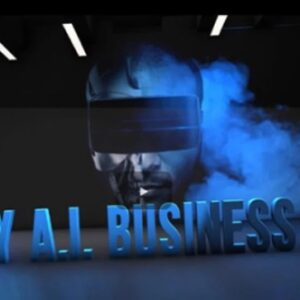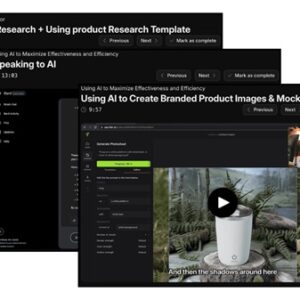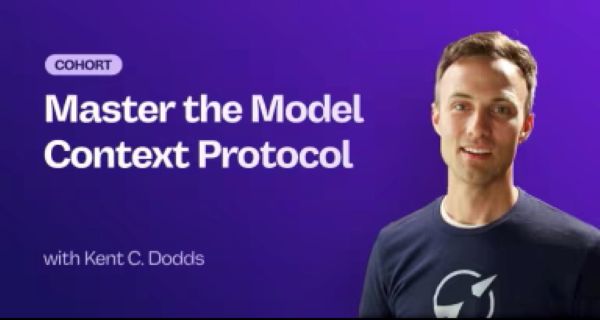[GroupBuy] Master the Model Context Protocol (MCP) – Kent C. Dodds
$525.00 Original price was: $525.00.$69.00Current price is: $69.00.
- Delivery: You Will Receive A Receipt With Download Link Through Email.
- If you need more proof ofcourse, feel free to chat with me!

Description
Table of Contents
ToggleTo truly Master the Model Context Protocol, developers must understand its foundational role in bridging the gap between AI capabilities and practical application functionality.
Master the Model Context Protocol
The advent of Large Language Models (LLMs) has undeniably revolutionized the landscape of artificial intelligence, ushering in an era where complex natural language understanding and generation are not just theoretical possibilities but tangible realities. However, the true potential of these powerful models has been significantly hampered by a fundamental disconnect: their inability to seamlessly and reliably interact with the core functionalities, data, and tools that power our applications. This is precisely the chasm that the Master the Model Context Protocol (MCP) seeks to bridge. MCP is not merely another technical specification; it is a foundational technology envisioned to be the bedrock for the next generation of AI-integrated applications.
It provides a standardized interface, a universal language, that allows LLMs and AI agents to structurally comprehend and engage with the intricate workings of an application. This goes far beyond the limitations of a simple chat interface, which often confines AI to reactive conversational roles. By defining a clear and consistent method for applications to expose their capabilities, MCP empowers a paradigm shift towards user interaction that is intuitive, natural, and autonomous, driven by natural language, voice commands, and intelligent agents.
The growing recognition of MCP’s significance is underscored by the urgent need for clear, up-to-date, and consistent documentation. Recognizing this void, educator Kent C. Dodds has developed the Mastering the Model Context Protocol Workshop, a meticulously crafted two-week intensive remote cohort program. This initiative aims to provide a comprehensive, pragmatic, and structured learning path, ensuring that developers can effectively leverage this transformative protocol. The curriculum is thoughtfully divided into four distinct workshops: MCP Fundamentals, Advanced Features, User Interface (MCP-UI), and Authorization (MCP Auth), each designed to build upon the last.
The learning model itself is a testament to the program’s focus on overcoming common educational hurdles. By combining scheduled daily lesson drops, vibrant community learning via Discord, and dual-session live office hours, the workshop addresses the challenges inherent in self-study and the inflexibility of traditional live training, offering a dynamic and supportive learning environment. The Master the Model Context Protocol is therefore not just about understanding a new technology; it’s about unlocking the next frontier of software development and user experience.
The Genesis and Core Purpose of MCP
The Master the Model Context Protocol is fundamentally defined as a standardized interface, a critical enabler for building what can be described as intelligent software. Its primary function is to establish a clear, reliable, and unambiguous method for applications of all kinds to expose their intrinsic tools, their rich resources, and their specific contextual data to LLMs and other sophisticated AI agents. This crucial capability allows AI to transcend the limitations of merely generating conversational responses. Instead, it empowers AI to reliably call upon, interact with, and consume an application’s core functions in a structured and predictable manner.
The source material articulates this perfectly by framing MCP as the definitive answer to a fundamental question plaguing current AI integration efforts: for an AI to actually do anything useful, to move beyond being a passive information provider, it requires more than just a chat box. It demands a robust, structured framework that allows it to intelligently interface with an application’s inherent capabilities and, crucially, with a user’s specific, often dynamic, data. This is where the true innovation of the Master the Model Context Protocol lies – in providing that essential framework.
My analysis suggests that the protocol’s design inherently addresses the combinatorial explosion of potential AI interactions. Without such a standard, each application would need to develop its own bespoke integration layer for every potential AI model or agent, leading to an unsustainable ecosystem of custom solutions. MCP, by providing a common language and structure, democratizes AI integration, making it accessible for a broader range of developers and applications. It shifts the burden from the AI model to the application, enabling applications to present their functionalities in a machine-readable and actionable format.
This is analogous to how APIs revolutionized traditional web development, providing a standardized way for different software systems to communicate. MCP aims to do the same for AI, allowing AI agents to dynamically discover and utilize the services offered by any MCP-compliant application. This standardization is key to fostering interoperability and innovation, allowing developers to focus on building compelling AI-powered experiences rather than wrestling with the complexities of disparate integration methods. The elegance of MCP lies in its simplicity and its direct focus on the problem: making application functionality accessible to AI.
Market Significance and the Vision for AI Integration
The Master the Model Context Protocol is not just a technical standard; it is positioned as a pivotal technology, boldly described as the most exciting development in software right now and the key to unlocking the future of AI integration. The protocol is designed to facilitate a profound and transformative shift in user experience across the digital landscape. We are increasingly moving towards a future where users will engage with their favorite applications not through traditional graphical user interfaces—the familiar pages, menus, and forms—but through more intuitive and natural means.
This includes natural language commands, spoken interactions, and the proactive assistance of AI agents. MCP is the enabling force behind this evolution, providing the necessary infrastructure for applications to gracefully adapt to these new interaction modalities. The vision is clear: to make software more accessible, more efficient, and more deeply integrated into our daily workflows by leveraging the power of AI.
The implications of this vision are vast. Consider the potential for productivity gains. Instead of navigating complex software interfaces to perform multi-step tasks, users will be able to articulate their intentions in plain language, and AI agents, powered by MCP, will be able to orchestrate the necessary actions within the application.
This could range from scheduling a meeting that automatically updates calendars and sends invitations, to generating complex reports by intelligently querying and synthesizing data from multiple sources. Furthermore, this shift promises to enhance accessibility for a wider range of users, including those with disabilities who may find traditional interfaces challenging. The Master the Model Context Protocol is therefore not just about technological advancement; it’s about creating a more inclusive and user-centric digital future. The ability for AI agents to “understand” and “act” upon application capabilities means that complex software can become more approachable, lowering the barrier to entry for individuals and organizations alike.
This democratization of advanced functionality is a powerful driver for innovation and widespread adoption of AI-powered solutions. The protocol’s emphasis on exposing tools, data, and capabilities in a structured manner ensures that AI can act with precision and reliability, avoiding the common pitfalls of misinterpretation or incomplete action that have plagued earlier attempts at sophisticated AI integration. This makes the vision of seamless AI-powered application interaction not just a futuristic concept, but an achievable reality.
MCP
The Master the Model Context Protocol (MCP) represents a significant leap forward in how applications and artificial intelligence will interact. At its core, MCP is an architectural pattern and a set of specifications that define a standardized way for applications to expose their capabilities, data, and tools to Large Language Models (LLMs) and other AI agents. This standardization is critical because, historically, AI integrations have been ad-hoc and often limited to simple conversational interfaces. MCP fundamentally changes this by enabling AI to not just understand but also to act within an application’s context. The protocol provides a structured framework for applications to declare what they can do, the parameters they require for those actions, and the data they can provide. This allows AI agents to dynamically discover and invoke these functionalities, moving beyond passive information retrieval to active task execution.
The Mastering the Model Context Protocol Workshop is specifically designed to equip developers with the knowledge and practical skills to implement MCP effectively. It addresses the current state of documentation, which is often fragmented and outdated, by offering a curated, pragmatic, and up-to-date curriculum. This intensive program covers everything from the fundamental building blocks of MCP to advanced features, user interface integration, and robust authorization mechanisms. The goal is to empower developers to build AI-integrated applications that are not only intelligent but also secure, reliable, and highly functional, truly embodying the promise of the Master the Model Context Protocol.
MCP Fundamentals: Building the Foundation
The initial phase of mastering the Master the Model Context Protocol begins with its fundamental architecture and core building blocks. This stage is crucial for establishing a solid understanding of how MCP operates and how to construct the initial components of an MCP-compliant application. The process starts with setting up a development environment that is conducive to building functional tools discoverable by AI assistants. This involves understanding the necessary libraries, frameworks, and configurations that enable an application to communicate effectively through the MCP interface. A key learning outcome here is the ability to declare tool support, which essentially means defining the specific actions or operations that the application can perform and that an AI agent can invoke.
This declaration is not arbitrary; it follows a structured format that the AI can parse and understand. Furthermore, MCP emphasizes robust argument validation, and the workshop utilizes tools like Zod to ensure that any data passed to an application’s tools is accurate and well-formed. This is vital for preventing errors and ensuring the reliability of AI-driven operations. Graceful error handling is another cornerstone of this module. Applications must be able to gracefully report back to the AI agent when an operation fails, providing helpful information for debugging or for the AI to attempt an alternative.
Beyond tools, MCP also focuses on exposing structured data through resources. This means defining how an application’s data can be accessed and queried by AI agents in a structured, machine-readable format. Finally, the module delves into creating reusable prompts, which are essential for guiding AI agents in their interactions and for ensuring consistent communication patterns. The ultimate outcome of this foundational workshop is the ability to build a complete, MCP-accessible journaling application, demonstrating the practical application of these core concepts.
The concept of “discoverability” is central to MCP Fundamentals. Just as a website needs to be discoverable by search engines, an application’s functionalities need to be discoverable by AI agents. MCP provides the mechanisms for this discovery through clear declarations and structured metadata. This ensures that an AI doesn’t have to guess what an application can do; it can query the application and receive a definitive list of available tools and resources. This programmatic discovery is a significant departure from traditional API integrations, where developers often needed to consult extensive documentation to understand an API’s capabilities. With MCP, the application itself becomes the documentation for the AI.
The use of Zod for argument validation is a pragmatic choice that aligns with modern software development practices. By enforcing strict schemas for input arguments, MCP helps to prevent a wide range of common errors, from incorrect data types to missing parameters. This proactive approach to error prevention significantly enhances the reliability of AI-driven workflows. Imagine an AI attempting to schedule a meeting. Without robust validation, it might pass an invalid date or time, leading to a failed operation. Zod, integrated via MCP, ensures that such invalid inputs are caught early, either by the application or even by the AI before it even attempts the call. This level of precision and control is what differentiates MCP from more rudimentary forms of AI integration.
The creation of reusable prompts is another critical aspect of MCP Fundamentals. Prompts are the instructions given to LLMs. By defining and standardizing prompts within the MCP framework, developers can ensure that AI agents consistently interact with the application and its tools in the desired manner. This is particularly important for tasks that involve complex workflows or require specific output formats. For example, a prompt to generate a summary of journal entries might be standardized to ensure that the summary includes key dates, themes, and sentiments, all of which can then be further processed by the AI or presented to the user.
This reuse of prompts promotes efficiency and consistency, reducing the need for repetitive prompt engineering for similar tasks. The holistic approach of MCP Fundamentals, culminating in a functional application, underscores the protocol’s practicality. It’s not just about theoretical concepts; it’s about building real-world solutions that leverage the power of AI in a structured and reliable way. This practical application of the protocol’s principles is what will ultimately drive its adoption and impact. The ability to build an MCP-accessible journaling application demonstrates that the core concepts are not abstract but immediately applicable to creating useful AI-powered tools.
Advanced MCP Features: Production-Grade Capabilities
Moving beyond the foundational elements, the Master the Model Context Protocol offers a suite of advanced features designed to equip developers with the capabilities needed for production-grade applications. This module delves into the nuances of creating sophisticated and robust AI integrations that can handle complex workflows, ensure data integrity, and provide rich user experiences. A key area of focus is the addition of sophisticated tool metadata. This includes properties like readOnly to indicate that a tool does not modify application state, destructive to flag operations that permanently alter data, and idempotent to signify that repeatedly calling a tool with the same parameters will have the same effect as calling it once.
This metadata is invaluable for AI agents, allowing them to make more intelligent decisions about which tools to use and how to use them, particularly in scenarios where safety and predictability are paramount. Implementing structured output schemas for machine-validated results is another critical component. This means defining the exact format and types of data that a tool will return, enabling AI agents and other systems to programmatically validate and process these results with high confidence. This is essential for maintaining data integrity and ensuring that downstream processes built upon AI outputs are reliable.
Mastering elicitation is a particularly powerful advanced feature within MCP. This refers to the ability to request structured user input mid-workflow, allowing the AI to dynamically gather necessary information from the user as the task progresses. Instead of requiring all information upfront, the AI can ask clarifying questions or request specific details at relevant points, leading to more natural and efficient interactions. For example, if an AI is tasked with booking a flight, it might first ask for destination and dates, and then, after retrieving available flights, use elicitation to ask the user for their preferred airline or seating preference. Furthermore, MCP sampling provides a mechanism to leverage the user’s own LLM for content generation.
This allows for personalized and contextually relevant content to be created on the fly, such as generating draft email responses or summarizing complex documents tailored to the user’s specific needs and style. Handling asynchronous operations is also a critical consideration for production systems. This module covers implementing progress reporting, cancellation flows, and real-time state notifications for operations that may take time to complete. This ensures that the user is kept informed about the status of long-running tasks, can cancel them if necessary, and receives timely updates. This comprehensive approach to advanced features ensures that applications can leverage MCP to build sophisticated, reliable, and user-friendly AI-powered experiences.
The concept of “idempotency” in tool metadata is particularly interesting from a resilience perspective. In distributed systems, ensuring that operations can be retried safely is a core principle for handling network failures or temporary service disruptions. By explicitly marking tools as idempotent, MCP allows AI agents to confidently re-attempt operations that may have failed due to transient issues, without fear of unintended side effects. This significantly increases the robustness of AI-driven workflows, making them more reliable in real-world, often unpredictable, environments.
The ability to solicit structured user input mid-workflow, or “elicitation,” represents a significant step towards natural and fluid human-AI collaboration. It moves away from rigid, form-based interactions towards a more conversational and adaptive approach. Imagine an AI helping a user plan a complex event. Instead of presenting a massive form with dozens of fields, the AI can guide the user through the process, asking for information only when it’s needed and in a clear, contextual manner. This makes the interaction feel less like filling out a form and more like a helpful assistant helping you achieve your goal. This is a critical advancement for user adoption and satisfaction in AI-powered applications.
The use of MCP sampling to leverage the user’s LLM for content generation is a fascinating aspect that hints at a future of highly personalized AI experiences. Instead of relying solely on the application’s predefined outputs or a generic LLM, this feature allows the AI to tap into the user’s own language model. This could mean generating text that perfectly matches the user’s writing style, summarizing information in a way that resonates with their specific knowledge base, or even composing creative content that aligns with their preferences. This level of personalization is a powerful differentiator and can lead to AI interactions that feel truly bespoke.
Finally, the detailed handling of asynchronous operations is a testament to MCP’s focus on production readiness. In many real-world scenarios, AI-driven tasks will not complete instantaneously. Providing mechanisms for progress reporting, cancellation, and real-time state notifications is essential for managing user expectations, preventing frustration, and building trust in the AI’s capabilities. This ensures that users are not left in the dark when an AI is performing a complex task, allowing them to monitor its progress and intervene if necessary. This comprehensive set of advanced features truly elevates the Master the Model Context Protocol from a conceptual framework to a powerful toolkit for building sophisticated AI integrations.
MCP UI: Rich Interactive Experiences
The Master the Model Context Protocol extends its transformative reach beyond mere functionality to encompass the user interface itself, ushering in an era of rich, interactive experiences. This module, MCP UI, addresses the critical need to move beyond plain text responses from AI and LLMs, enabling them to deliver dynamic and engaging user interfaces directly within applications. The core innovation here lies in the ability to transform simple text outputs into interactive UIs.
This means that instead of a chatbot simply stating a piece of information, it can present that information in a visually appealing and interactive format, such as a card, form, or even a full-fledged component. The @mcp-ui/server package is a key tool introduced in this module, providing the foundational capabilities for generating basic HTML responses that can be rendered within an application’s context. This allows for a more structured and controlled presentation of AI-generated content compared to raw, unformatted text.
Ensuring consistency with host applications is a paramount concern for a seamless user experience, and MCP UI addresses this through the concept of remote-DOM. Remote-DOM allows the AI-generated UI components to integrate seamlessly with the host application’s existing structure and styling, maintaining a cohesive look and feel. This prevents jarring visual discrepancies and ensures that the AI-powered elements feel like a natural extension of the application, rather than an alien insertion. The focus is on building responsive UIs that can dynamically display lists of items, trigger specific actions within the application, and communicate back to the host application via post messages.
This bidirectional communication is crucial for creating truly interactive experiences. For instance, an AI might present a list of available products. A user could then select an item from this list, triggering an action within the application to view product details or add it to a cart. This interaction is facilitated by the post message communication, allowing the AI-generated UI to send commands or data back to the host application. Modern frameworks are leveraged to ensure that these UIs are not only functional but also aesthetically pleasing and adaptable to various screen sizes and devices, further enhancing the user experience. The Master the Model Context Protocol is thus not just about making AI functional, but also about making it engaging and visually compelling.
The idea of transforming text responses into interactive UIs is a significant advancement in human-computer interaction. It acknowledges that while LLMs are excellent at generating prose, users often benefit from structured and visual representations of information. For example, an AI analyzing a financial report might generate a textual summary. However, presenting key figures, trends, and anomalies in interactive charts or tables, powered by MCP UI, would be far more effective for comprehension. This blend of natural language understanding and visual presentation creates a powerful synergistic effect.
The use of remote-DOM to ensure consistency with host applications is a crucial detail for enterprise adoption. In many companies, brand consistency and user interface guidelines are strictly enforced. MCP UI’s ability to adhere to these guidelines means that AI-powered features can be integrated without compromising the established user experience, fostering trust and adoption within corporate environments. It allows for AI to augment existing workflows without disrupting them visually or functionally.
The communication via post messages is the backbone of this interactive capability. It’s the digital handshake between the AI-generated UI elements and the host application. Consider a scenario where an AI suggests a travel itinerary. A user might select a particular flight from a list presented by the AI. This selection, processed by the AI-generated UI, would then send a post message to the host application, perhaps to initiate the booking process or to update a calendar. This asynchronous, event-driven communication model allows for complex interactions to be built incrementally and with flexibility.
It enables the AI to act as a dynamic interface builder, responding to user input and application state changes in real-time. The ability to build responsive UIs with modern frameworks further empowers developers. This means that the interactive elements generated through MCP UI can be built using the same tools and techniques they are already familiar with, such as React, Vue, or Angular. This reduces the learning curve and allows for the rapid development of sophisticated AI-powered interfaces that are both functional and aesthetically pleasing. The Master the Model Context Protocol, through its UI module, is fundamentally reshaping how users perceive and interact with AI-driven applications, making them more intuitive, engaging, and powerful.
MCP Auth: Secure, Authenticated Interaction
Security is a paramount concern in any software development, and the Master the Model Context Protocol explicitly addresses this through its robust authorization module. This section focuses on implementing enterprise-grade security, ensuring that AI agents and applications interact in a secure and controlled manner, especially when dealing with sensitive data and functionalities. The protocol leverages the official MCP authorization specification and the widely adopted OAuth 2.1 standard to achieve this. OAuth 2.1 provides a secure framework for delegated authorization, allowing third-party applications (in this case, AI agents) to access resources on behalf of a user without directly handling their credentials. A critical aspect of this is exposing OAuth metadata. Applications compliant with MCP Auth must clearly define their OAuth endpoints and supported flows, enabling AI agents to correctly initiate and manage authorization processes.
Triggering authorization flows from host applications is a key mechanism. When an AI agent needs to perform an action that requires user permission, the host application can initiate the OAuth 2.1 flow. This typically involves redirecting the user to an authorization server to grant consent. Once consent is obtained, the AI agent receives an access token, which it can then use to make authenticated API calls to the application. Resolving client tokens into MCP Auth Info is another crucial step. The application needs to be able to take the access token provided by the AI agent and translate it into a standardized format of authentication information, known as MCP Auth Info.
This info contains details about the authenticated user, their permissions, and the context of the request, allowing the application to make informed authorization decisions. Implementing scope-based security is the final layer of defense. Scopes define the specific permissions that an AI agent has been granted. By requiring AI agents to request specific scopes and by enforcing these scopes at the API level, applications can protect against unauthorized requests and ensure that AI agents only access the data and perform the actions they are explicitly permitted to. This meticulous approach to security is vital for building trust and ensuring the safe deployment of AI-integrated applications, making the Master the Model Context Protocol a secure foundation for innovation.
The integration of OAuth 2.1 within MCP Auth is a strategic decision that leverages a well-established and battle-tested security standard. This avoids the need to reinvent the wheel for authentication and authorization, allowing developers to build upon existing best practices. By exposing OAuth metadata, MCP ensures that AI agents can discover and understand how to authenticate with an application, simplifying the integration process. The emphasis on triggering authorization flows from the host application is a user-centric approach. It ensures that users are in control of their data and have the explicit opportunity to grant or deny permissions to AI agents.
This transparency builds trust and addresses common user concerns about AI accessing their information without consent. The process of resolving client tokens into MCP Auth Info is a vital bridge between the OAuth flow and the application’s internal authorization logic. It standardizes how authentication information is presented to the application, regardless of the specific OAuth provider or flow used. This abstraction simplifies the application’s internal security implementation, allowing it to focus on enforcing policies based on the provided Auth Info.
Scope-based security is the granular control mechanism within MCP Auth. Imagine an AI agent designed to manage a user’s calendar. It might require scopes for “read calendar events,” “create calendar events,” and “delete calendar events.” By enforcing these scopes, the application can ensure that the AI agent performs only the actions it’s authorized to. If the AI agent attempts to access user contacts without the appropriate scope, the request would be denied. This fine-grained control is essential for mitigating security risks and preventing potential misuse of AI capabilities.
It allows for a dynamic and flexible security model that can adapt to different AI agent roles and permissions. The Master the Model Context Protocol, through its robust authorization module, provides the necessary guardrails to ensure that the power of AI integration is harnessed responsibly and securely, making it a truly enterprise-ready solution. This focus on security is not an afterthought but a fundamental design principle, ensuring that the future of AI-integrated applications is built on a foundation of trust and safety.
Conclusion
The Master the Model Context Protocol (MCP) emerges as a critical and transformative technology, fundamentally reshaping the future of AI-integrated applications by providing a standardized interface for LLMs and AI agents to structurally understand and interact with an application’s capabilities, data, and tools. This protocol directly addresses the current limitations of AI integrations, enabling actions beyond simple chat interfaces and facilitating a paradigm shift towards natural language, voice, and autonomous agent-driven user interactions. The Mastering the Model Context Protocol Workshop, led by Kent C. Dodds, offers a comprehensive, pragmatic, and structured two-week intensive program covering MCP Fundamentals, Advanced Features, MCP UI for rich interactive experiences, and MCP Auth for secure, authenticated interaction, all designed to equip developers with the essential skills to leverage this pivotal technology effectively.
Sales Page:_https://www.epicai.pro/cohorts/master-mcp
Delivery time: 12 -24hrs after paid
Related products
-
Sale!

Billy’s 10-Day Business Blueprint AI Advantage
$199.00Original price was: $199.00.$23.00Current price is: $23.00. -
Sale!

Clare Le Roy – Notion and Creators Canva Template Bundle
$528.00Original price was: $528.00.$25.00Current price is: $25.00. -
Sale!

[GroupBuy] A.I. Revolution Bundle Faceless – A.I. Digital Creator Bundle
$197.00Original price was: $197.00.$19.00Current price is: $19.00. -
Sale!

The Blueprint Reloaded by Owen Cook
$298.00Original price was: $298.00.$24.00Current price is: $24.00.

Reviews
There are no reviews yet.